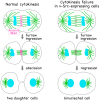Cytokinesis Failure Leading to Chromosome Instability in v-Src-Induced Oncogenesis
- PMID: 28417908
- PMCID: PMC5412395
- DOI: 10.3390/ijms18040811
Cytokinesis Failure Leading to Chromosome Instability in v-Src-Induced Oncogenesis
Abstract
v-Src, an oncogene found in Rous sarcoma virus, is a constitutively active variant of c-Src. Activation of Src is observed frequently in colorectal and breast cancers, and is critical in tumor progression through multiple processes. However, in some experimental conditions, v-Src causes growth suppression and apoptosis. In this review, we highlight recent progress in our understanding of cytokinesis failure and the attenuation of the tetraploidy checkpoint in v-Src-expressing cells. v-Src induces cell cycle changes-such as the accumulation of the 4N cell population-and increases the number of binucleated cells, which is accompanied by an excess number of centrosomes. Time-lapse analysis of v-Src-expressing cells showed that cytokinesis failure is caused by cleavage furrow regression. Microscopic analysis revealed that v-Src induces delocalization of cytokinesis regulators including Aurora B and Mklp1. Tetraploid cell formation is one of the causes of chromosome instability; however, tetraploid cells can be eliminated at the tetraploidy checkpoint. Interestingly, v-Src weakens the tetraploidy checkpoint by inhibiting the nuclear exclusion of the transcription coactivator YAP, which is downstream of the Hippo pathway and its nuclear exclusion is critical in the tetraploidy checkpoint. We also discuss the relationship between v-Src-induced chromosome instability and growth suppression in v-Src-induced oncogenesis.
Keywords: YAP; chromosome instability; cytokinesis; tetraploidy checkpoint; v-Src.
Conflict of interest statement
The authors declare no conflict of interest.
Figures



References
Publication types
MeSH terms
Substances
LinkOut - more resources
Full Text Sources
Other Literature Sources
Miscellaneous

